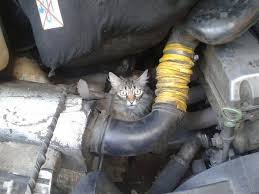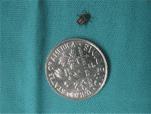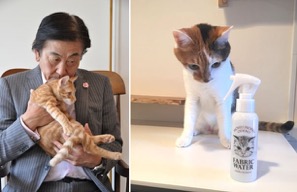Can Our Pets Commit Suicide?
Dr. Nicholas Dodman, Tufts University School of Veterinary Medicine
 Dr. Nicholas Dodman, Program Director for the Animal Behavior Department at Tufts, researched several alleged cases of pet suicide to see if it's possible. Few have studied the question more than Dr. Dodman. He's here to report on his findings and to answer the provocative question.
Dr. Nicholas Dodman, Program Director for the Animal Behavior Department at Tufts, researched several alleged cases of pet suicide to see if it's possible. Few have studied the question more than Dr. Dodman. He's here to report on his findings and to answer the provocative question.
Dr. Dodman does hear accounts of such things and tells us the story of a long time ago when someone stated their pet did commit suicide in downtown Manhattan. When they were asked what happened, they said that when they were taking their dog down the stairs, the dog suddenly turned around and fled back up two to three flights of stairs to the top, went through an open door and threw himself off the top of the building.
Upon further inquiry, Dr. Dodman found out that the dog was noise phobic and on Prozac at the time. The owners blamed the Prozac for causing the suicidal ideation. However, the dog was on a flexi-lead and again, he was noise phobic. The man had dropped the lead and it went bouncing down the stairs, making a clatter right behind the dog. This caused the dog to turn around and flee. Unfortunately since the lead was still attached, it followed the dog, who kept running.
Is it possible that our animals can have the same mental illnesses that we have? Dr. Dodman states, "Absolutely." Over the last 25 years or so, we have identified dogs with obsessive-compulsive disorders and dogs with other anxiety related behaviors. We've recently identified dogs that have autism; where you can actually measure things in the blood call bio-markers, that area exactly the same as an autistic child. They also have the same sex pre-selection, which mainly affects the males. They engage in the same behaviors as children and even have associated seizures.
PTSD (Post-Traumatic Stress Disorder) has also been identified in dogs, which Dr. Dodman identified long before the military finally caught on and now acknowledges that there is a canine form of PTSD.
It seems that since dogs have the same anxieties that we have, why can't they commit suicide? Dr. Dodman states that they do have depression. There is a state of depression, which dogs go into, that when they are bereaved over the death of another animal or their human, they can go into an extreme funk, with all of the signs appearing very similar to how people react with depression. This leaves them feeling that live is grey, they have no interest in it, they don't want to play nor socialize and they just want to sit around and sleep and maybe even stop eating.
There have even been instances where cats have stopped eating during bereavement. When cats stop eating, they can get a fat liver disease called hepatic lipidosis. Dr. Dodman has treated cats for this disease as well as the accompanying depressions.
However, there is a difference with animals in that they get into a state of depression. When you talk about depression in people who are depressed over the death of a loved one, while they are down and blue, they usually get over it. But there are some people who spontaneously get into depression and bounce back out, sometimes becoming manic and then depressed again. So they have a trait, which is different from a state.
 Dr. Dodman states that we have not really identified, and therefore he states that he's not saying it doesn't exist, but no one's described trait aggression. If it did occur in a dog, it would be one with a pessimistic personally and outlook and it has been shown that some dogs seem to behave in a pessimistic way while others, like human beings, can be optimistic about life and that every day is the best day of the rest of their lives.
Dr. Dodman states that we have not really identified, and therefore he states that he's not saying it doesn't exist, but no one's described trait aggression. If it did occur in a dog, it would be one with a pessimistic personally and outlook and it has been shown that some dogs seem to behave in a pessimistic way while others, like human beings, can be optimistic about life and that every day is the best day of the rest of their lives.
So how does Dr. Dodman explain stories like the ivy-covered, stone Overton Bridge in the Scottish Lowlands town of Dumbarton where people state dogs go and jump off to their death?
Dr. Dodman feels there could be another explanation. First of all, he states that the bridge in Scotland is not properly secured even for humans. Normally tall bridges where people have jumped from in the past have netting and fences to stop people from jumping. But if the bridge has unsecured edges and you can't see what's on the other side, Dr. Dodman imagines that the bridge is fairly open and perhaps there are birds that are flying by, maybe it's near a rookery, and dogs are just chasing the birds and falling off the bridge. So far, over 10 dogs have jumped off the bridge.
Dr. Dodman feels that dogs know they are an entity. They know that they are themselves and other dogs and people are different. There are still people who don't feel dogs know this, but the fact that some people realize this is quite a jump to intelligence. However, to know that you are yourself and you want to end your life, which means you know that it began and you know that it's going to end, Dr. Dodman doesn't feel that dogs know that.
Cold Weather Tips
Doc Halligan, Lucy Pet Foundation
People may not realize that dogs and cats can get frostbite and hypothermia, which can lead to death, just like humans. So if it's too cold for you, it's too cold for them!
1. Very young, thin or malnourished and older animals are much more susceptible to frostbite and hypothermia than adult animals. These pets should be kept inside during cold weather if possible.
2. If your pet lives outdoors make sure you provide proper shelter. This should include a warm insulated pet house that is elevated enough so that moisture cannot accumulate inside. If possible, try to provide a door to keep out any winter winds.
 3. Every year cats and dogs die from ingesting antifreeze. Even a small amount of antifreeze can be fatal. Take all precautions to keep this product away from pets.
3. Every year cats and dogs die from ingesting antifreeze. Even a small amount of antifreeze can be fatal. Take all precautions to keep this product away from pets.
4. Pets are susceptible to frostbite so make sure you remove ice and snow away from your pet's paws and coats immediately. You can even put booties and coats on them for protection.
5. Certain substances used to melt ice and snow are toxic to pets so be sure to keep these away from your pets reach and clean their feet when they come inside.
6. Avoid using metal bowls, as the water will freeze much faster in this type of water bowl. Also, pet's tongues can get stuck to the surface as well.
 7. Cats will often climb into vehicle engines for warmth so before starting your car make sure you knock on the hood and honk the horn. Even if you do not own a cat, your neighbor's cats may be seeking refuge in your car's engine or on your car's tire.
7. Cats will often climb into vehicle engines for warmth so before starting your car make sure you knock on the hood and honk the horn. Even if you do not own a cat, your neighbor's cats may be seeking refuge in your car's engine or on your car's tire.
Even if your pet is inside, the cold weather can bring out arthritis in the elderly. Make sure you have padded beds and blankets for them to lie on instead of the cold floor or tiles. In the winter, many animals require more calories to stay warm when they go outside, so make sure you feed your pet accordingly, about 25-percent more calories for an animal that goes outside. But if you have a couch potato dog that uses an indoor potty, you don't need to feed them more in the winter.
The Mission of The Lucy Pet Foundation is to reduce pet overpopulation by having mobile spay/neuter clinics across the country and to support causes that benefit animal welfare. The Lucy Pet Foundation currently has two buses that travel around Southern California focusing on spaying and neutering. These buses are state of the art surgery units. Their next focus is in generating more funds to expand the work of these buses and have more across the country.
 The Lucy Pet Foundation not only offers free and reduced spays and neuters, they also do microchipping, vaccines and de-wormings. Spaying and neutering is not only great for pet population control, but it has been proven that an animal will live on an average of 40-percent longer after having this surgery.
The Lucy Pet Foundation not only offers free and reduced spays and neuters, they also do microchipping, vaccines and de-wormings. Spaying and neutering is not only great for pet population control, but it has been proven that an animal will live on an average of 40-percent longer after having this surgery.
5 Things We Do That Give Pets Complexes
Robert Semrow, Animal Radio Listomania
It's Robert Semrow, your pet world insider here with this week's Animal Radio Listomania.
Help, my pet has attitude! What's the deal and why the pet complex? Well, that may be something that we've caused by what we're doing.
If your dog or cat is giving you attitude and you can't figure out why, let me help with a few common things that I think our four-legged friends wish we'd think of before acting upon.
 1. Pet Strollers
1. Pet Strollers
That's right, we've all seen the latest in high-tech and low-tech strollers for our four-legged friends. Do you think nature bestowed them with four legs so they could ride comfortably in a wheeled contraption meant for those that can't walk or haven't yet learned to walk? I admit it. It's certainly cute and sometimes it's medically necessary. But let's make sure they're getting plenty of exercise and remember we do have a pet obesity crisis.
2. Clothing For Pets
I know, I'm the Pawtographer and I am certainly guilty of loving a pet in a cute outfit and I can appreciate the work of pet fashion professionals. However, unless it's a need, and I'm thinking of you the shorthaired pets in the winter, sweaters, clothing and costumes can be very uncomfortable and can even cause over-heating issues for our pets. Never force a pet to wear an outfit, a hat or even a wig. They've got their own fashion sense and we want them to be able to roll with pride at the local dog park.
3. Snuggies For Pets
That's right, it's a separate category. While pets have a natural nesting instinct, you don't see them trying on sweaters or blankets at the local flea market. Dogs and cats enjoy warmth, but enjoy freedom more. I look ridiculous in a human snuggie and a dog might just send me a fragrant message if I wrap them in a dog snuggie. Being wrapped up as a baby when they're scared can give your pet comfort, but having them wear a blanket if they're not a Charles Schultz character can get them laughed at during a dog park visit.
 4. Pet Shoes & Socks
4. Pet Shoes & Socks
Again, if you're a rescue dog climbing over dangerous debris, by all means, get some safety footwear in place. If you're a senior that slips on tile floors, it makes sense to have sock and shoes for your paws. But if you're a dog or cat being forced to wear shoes or socks to be fashionable, remind your pet parents that you sweat and regulate your body temperature through the pads of your paws. Prolonged covering can be harmful.
5. Pet Bling
Pets are more blingy than ever. From necklaces, to toenails to tiaras, I can appreciate showering your pets with love, but keep in mind that these shiny objects look more like toys and distractions than fashion statements for your pets.
Oh heck, now I know why my pets have so many complexes! I'm putting down the snuggie right now. Remember, your pet trusts you and wants you to be happy. Make sure you're giving them the same consideration.
Share your pet complexes with us on the Animal Radio Facebook Page.
http://petworldinsider.com
 Ticks Hitchhike on City Dogs Too - Dr. Debbie
Ticks Hitchhike on City Dogs Too - Dr. Debbie
Ticks are common parasites known to infect people, pets and spread disease. Over 850 tick species exist worldwide, although fewer than a dozen species are of risk to pets in the U.S. But here in Las Vegas, pet owners often dismiss the existence of ticks with the likes of Bigfoot or the Loch Ness Monster. Think ticks are only a problem for pets that travel or visit the mountains? Think again.
The Tick Tale
Ticks are parasites known to infect mammals, reptiles and birds and feed on their host's blood. Although of tiny size, ticks ingest 200 to 600 times their weight in a blood meal.
Ticks are attracted to a host's movement, body warmth or exhaled carbon dioxide and then latch on. Through this feeding behavior they can transmit diseases to pets such as Lyme disease, Rocky Mountain spotted fever, Ehrlichia, Babesia and Tularemia. Disease transmission takes some time and may occur after 36 to 48 hours of feeding behavior.
Some ticks can live months or up to a year off its host without a feeding, so year-round prevention is important for pets at risk for continued exposure.
Battling Ticks
There are many topical tick control products available for pets. Speak with your veterinarian for an product that is effective and safe with your pet's individual health in mind. Cats are sensitive to some ingredients, may develop toxicity, and should never be treated with a product labeled only for dogs. Additionally, pet owners using multiple products on their pet should first consult with their veterinarian to ensure safe use of combined products.
In addition to topical tick control, environmental treatment with foggers, sprays or pest control service should be considered for heavy infestations. Limit tick habitat zones by maintaining landscaping, avoiding overgrown grass and keeping shrubs and plants trimmed.
Pet Screening
Perform daily tick checks during tick season. Examine your pet for ticks in areas that the parasites hang out - around the head, behind ears, armpits and between toes.
When removing a tick, avoid handling it directly. Wear gloves or handle with Kleenex since ticks can pass infections to people as well. Grasp the tick with tweezers close to the skin. Extract the tick by pulling straight out of skin. Don't squeeze, twist or leave any legs behind. Disinfect the area and dispose of ticks in rubbing alcohol.
 Here's a photo of a typical tick, born and bred in Las Vegas and recently extracted from one of my Shih Tzu patients named Kane. Kane never leaves the state, doesn't hike in the mountains, and enjoys the comforts of a house-dog lifestyle. A tick was discovered on Kane after a day of supervising his owner's yard work and shrub trimming.
Here's a photo of a typical tick, born and bred in Las Vegas and recently extracted from one of my Shih Tzu patients named Kane. Kane never leaves the state, doesn't hike in the mountains, and enjoys the comforts of a house-dog lifestyle. A tick was discovered on Kane after a day of supervising his owner's yard work and shrub trimming.
Maybe Kane's story will be an eye-opener for city dwelling pet owners. Pet parasites like fleas, ticks and mosquitoes still lurk in that urban jungle.
Visit the Dogs & Ticks website for more information ticks, diseases and prevention.
Featured veterinarian known as "Dr. Debbie" on national pet radio program, Animal Radio. Ebook author of "Yorkshire Terriers: How to Be Your Dog's Best Friend"; "Pugs: How to Be Your Dog's Best Friend"; "Mini Schnauzers: How to Be Your Dog's Best Friend"; and "Shih Tzu: How to Be Your Dog's Best Friend."
http://www.drdebbie.net
 The Dogfather's Grooming Tip with Joey Villani
The Dogfather's Grooming Tip with Joey Villani
Protect Your Dog From The Cold
With the colder weather, people are grooming their pets less. But if you have a dog that's matted or full of shedding hair, let a groomer take care of it.
You can always put a coat on a shaved dog and if your dog is de-shedded properly, their remaining coat will keep them warm. But if you take an already matted dog out in the snow, or it gets wet, it will absorb the moisture like a sponge. This will keep the cold, damp moisture up against your pet's skin, which is not good.
You should also keep an eye on your dog's pads if they go out in snow or ice. There are salt and chemicals that are used to melt ice on roadways and sidewalks that your pet can walk in. Make sure you clean their feet every time they have been outside.
One thing people forget is that snow can become impacted between a dog's pads. This can be very uncomfortable and cold for your pet. Some people don't like to shave the pads of their dog's feet, while some do. But either way, check out your pet's feet and dig out any snow.
Remember, their skin reacts just like our skin. Their skin will also dry out during the winter with heaters being used in homes. If you notice your skin is dry during the winter months, you can be sure our pet's skin is dry as well.
To combat dryness, you can purchase a conditioning spray that will moisturize your pet's skin or even just water in a spray bottle. Occasionally spray your pet down while they are inside and it will hydrate their skin and coat. To keep the pads of their feet and nose nice and soft, you can apply Vaseline. There are special products made just for their feet and nose, like bag balm, but in a pinch, Vaseline will work.
And lastly, if your dog doesn't have much hair on their ears, you can also apply Vaseline before going outside. This will actually protect their ears and keep them from getting chapped. It will also actually hold the heat in and keep your pet's ears a little warmer.
 Animal Radio News - Lori Brooks
Animal Radio News - Lori Brooks
Laws Protect Pets Left Out in the Cold
While many states mandate that pets are not allowed to be kept outdoors in extreme weather for extended periods of time without insulated housing, others barely consider hypothermic deaths to be animal cruelty. Fortunately, some states and local governments are now enforcing harsher punishments for people who allow their pets to perish in weather extremes like the recent blizzard on the east coast. Talk about perfect timing, Montgomery County, Maryland had just recently taken measures to ensure that dogs, specifically, would not be forced to endure the winter tied up outside. The Counties Animal Services Division says "A person must not tether a dog under circumstances that endanger its health, safety, or well-being including: unattended tethering of the dog during a weather emergency such as that blizzard which dumped more than 3 feet of snow in many parts of the county.
 Get The Smell Of Fresh Cat Head in a Bottle
Get The Smell Of Fresh Cat Head in a Bottle
If you own a cat you probably know this some, but some people apparently think the back of their heads smells wonderful. A Japanese company has researched that scent, recreated it, and is now bottling and selling it. Okay, not all cats smell good but according to the creator in Japan, this is quite common and many Japanese cat owners describe the scent as everything from the smell of sunshine to the sweet scent of just baked bread. So, the head of Yamamoto Perfumery, Mr. Yamamoto himself, spent four months doing research sniffing many cats' heads. It took 4 months and a lot of cat sniffing to replicate the smell, but they've done it. The result? Fluffy Brow Scented Fabric Water. It can be sprayed on fabrics or anything to give them a lovely cat-head smell. A bottle sells for 1,200 yen or about $10 each.
 Woman Has Over 1,000 Cats
Woman Has Over 1,000 Cats
A woman in California has 1,000 cats, but she's no hoarder. Lattanzio runs "Cat House on the Kings," the largest cat sanctuary in the state. It all started when she volunteered to bottle feed kittens for a rescue back 25 years ago. She had a home of her own, and quickly found her purpose in life then went about creating a no-kill shelter to provide all cats with a safe place to live. With euthanasia not being an option, cats are allowed to roam peacefully among each other at the 12-acre property, which is sort of a feline paradise. The facilities include a kitten quarantine building, an ICU, a hospital room and a retirement room for senior cats. So how much does it cost to keep a thousand cats? Yearly expenses are $1.6 million, but all of the funds come from donations. Today, Cat House on the Kings has 45 paid personnel who help to care for the cats and maintain the property including a veterinarian and seven vet techs, who are also part of the team.
 Hundreds of Police Dogs and Handlers Attend Police Dog's Funeral
Hundreds of Police Dogs and Handlers Attend Police Dog's Funeral
You probably heard about the Ohio police dog who died last month after a being shot in the face, neck and shoulder during a grocery store robbery. K-9 officer Jethro passed with his partner, Officer Ryan Davis, by his side while at a vet hospital. The social media outpouring of sympathy was huge, as was the funeral service held for Jethro. Hundreds of police officers and K-9 officers and their dogs from across the country attended to pay their respects. Literally, more than a hundred police dogs and their handlers walked in a procession for Jethro at the funeral, which was held on what would have been Officer Jethro's 3rd birthday.
 Kitten Thinks She's a Husky
Kitten Thinks She's a Husky
If you haven't met or seen Rosie, the kitten who thinks she's a Husky, it's something you should do for yourself. She's adorable. Rosie was only a 3-week-old kitten when she was found on the street, alone and unresponsive. She was nursed back to a healthy life by Lilo, a Husky. Now she's fully-grown and enjoying lots of adventures with a trio of Huskies who have taken Rosie in as part of their pack, leading Rosie to thinks she's a Husky. Rosie's adopted Mom, Lilo, is the leader of the pack so the other two dogs didn't question accepting the kitten as part of their family. Now Rosie goes outside to potty with the dogs, walks on a leash with the dogs and basically goes everywhere the three huskies go. You can follow their adventures on Facebook or Instagram.
 Listen to the entire Podcast of this show (#1259)
Listen to the entire Podcast of this show (#1259)





